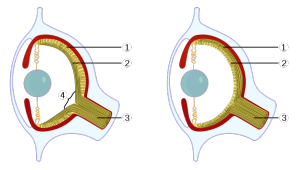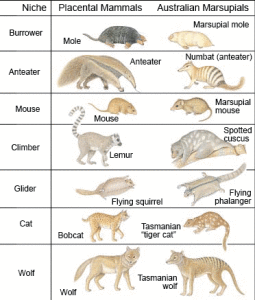When we discuss chapter 4 this week, ‘Evolution of the Theory’, we’ll see some examples of scientific discoveries after Darwin’s time.
Evo-Devo or “Teaching Old Genes New Tricks” (from John Horsley)
Evo-Devo is an abbreviation of evolutionary development biology, a field of biology that studies the way in which the development of the embryo has been influenced by evolutionary forces.
The development of an embryo in an animal is controlled by a group of genes, called Hox genes, which lay out the basic ‘body plan’ of the animal – i.e. these genes control where limbs and other body parts appear in the embryo. Amazingly, it has been found that these genes are almost identical in all animals, (fruit flies, mice, humans….). Nevertheless animals end up with very different forms (“endless forms most beautiful…..” ) so some other factor must be responsible for this diversity.
It turns out that the Hox genes control ‘switches’ in the DNA that determine when the genes that actually make the proteins for the body parts are turned on or off. Differences in the activation of these switches in time and space as the embryo develops produce the diversity we observe. The Hox genes have been called a basic ‘tool box’ that is used in different ways to make different animals. Evolution, then, may largely be driven by mutations that cause changes in this network of basic control genes and switches. Fairly minor changes in this network, just ‘tweaking’, can lead to large differences in form; this is why humans and chimpanzees are so different although their genome is 99% identical.
Another way to look at evo-devo is that the basic genes provide the ‘theme’ and the changes in timing are the ‘variations’, but there is no composer, just improvisation, as in playing jazz. Interestingly, this was a metaphor for the way God works through evolution suggested by Elizabeth Johnson in a paper she wrote a few years ago. But this is a topic for the second part of our discussion.
Epigenetics and Evolution (from John Horsley)
 Jean-Baptiste Lamarck (1744 -1829)
Jean-Baptiste Lamarck (1744 -1829)
Before Darwin came on the scene, the French biologist Jean-Baptiste Lamarck put forward a theory of evolution based on the inheritance of characteristics that were acquired by an organism during its lifetime. This type of inheritance has been strongly rejected by mainstream biologists for almost a century, but recent research in a relatively young field called epigenetics has indicated that in some circumstances Lamarckian evolution may in fact occur.
Epigenetics involves changes in the activity of genes that do not involve changes in the genetic code (the sequence of the four bases, ACGT, in DNA). It is known that environmental influences, such as toxic chemicals and also traumatic experiences produce ‘genetic markers’, chemical tags on the DNA that can block the action of a gene. It was assumed that these labels were lost when the DNA was transmitted to the next generation, but there is growing evidence that epigenetic marks can be transmitted over at least a few generations, leading to observable changes in descendants. The idea that a kind of Lamarckian inheritance is possible is an enormous paradigm shift, and the implications have only begun to be explored. The combination of epigenetics with evo devo (see above) is an especially exciting prospect.
Convergent evolution (from Rob Ross)
One of the arguments against Darwin’s theory of evolution is the marvelous, even miraculous, way that living organisms are adapted to their environment. Since Darwin’s day, biologists have come to recognize that such adaptation often occurs independently in different groups of organisms, long after they diverged. Here are two examples:
(1) Marsupial vs. Placental Mammals
The marsupial mammals of Australia – which have pouches to nurture the very young – diverged from the much more common placental mammals about 160 million years ago. Because of the geographical isolation of Australia, marsupials evolved to fill the ecological niches that are filled by placental mammals in the rest of the world. This figure shows how closely some of Australia’s marsupials resemble the placental mammals in the rest of the world.
(2) The Eye

Vertebrate eye…………………..Cephalopod eye
It’s hard to understand how the intricate design of the vertebrate eye could come about through ‘mere’ evolution, but cephalopods (such as the octopus) independently evolved to have an eye that is equally intricate – and at first glance looks very similar to the vertebrate eye. However, when you look closely, one is inside-out relative to the other. In a vertebrate eye the nerve fibers run in front of the retina, blocking some light and creating a blind spot when the nerve bundle passes through the retina. In a cephalopod eye the nerve fibers run behind the retina, and so do not block any light or create a blind spot.
To view the remarkable PBS video, ‘What Darwin Never Knew’ go to
http://video.pbs.org/video/1372073556/
To add your comments or questions,
click on ‘Leave a Reply’ or ‘Replies’ (below).



This is completely amazing, although it has the intuitive appeal that inspired Lamarck. The facts that have been established along the way enrich our understanding of how this is working. Each of these advances is so exciting!
I’m not sure whether this example qualifies as convergent evolution: the elephant seal on the west coast and the manatee, which is a different genus, a sirenian, on the east. They look very much alike, but are very different. The seal is a carnivore that prefers deep, cold water. The manatee is a vegetarian that craves warm surface waters. [There was a west coast vegetarian sirenian, but it was hunted to extinction in the 18th century. ] any insights on these two marine mammals welcome.